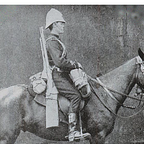Heroes of the West Africa Squadron.
A forgotten history of the British role in ending slavery
There are no statues of these men, they are long forgotten so we don't remember them. They are not even mentioned anymore when slavery is mentioned, however, in the 1800s they were by far heroes that helped put a stop to the Slave trade that was coming out of Africa.
One such man was Sir Henry Leeke. Born in 1790 Henry joined the Royal Navy when he was only 13 years old, in September of 1803. In 1809, he served as a Midshipman to Captain Charles Bullen during action against the French at the Bay of Rosas, during which 15 British men were killed and 55 wounded. Coincidentally, Charles Bullen would later become Commodore of the West African Squadron, 1824–1827.
Henry spent three years on the West Africa Squadron and is said to have contributed to the liberation of over 3 000 enslaved Africans. In May 1820, Leeke led 350 men of the Squadron and the West Indies Regiment against a force of 5 000 men, led by a local African leader, King Munga-Brahma. The King had recently killed one officer and several men onboard another of the Squadron’s ships, the Thistle, and had taken three other men prisoner. Leeke’s action secured the release of the prisoners and saved the colony from further bloodshed.
Henry Leeke is remembered as a highly active officer of the Squadron and in 1835, he received a Knighthood for his services on the coast of Africa, becoming Sir Henry Leeke.
WHAT IS HE BEST REMEMBERED FOR?
Sir Henry was in command of the Myrmidon in 1822, cruising the waters of the Gulf of Guinea, when the ship captured a Portuguese slave-vessel. Onboard the slave ship was a young boy called Adjai who had been kidnapped along with his mother and sister and sold to the Portuguese to be transported across the Transatlantic and sold as a slave. Sir Henry removed the slaves from the Portuguese vessel and placed them on board his own ship, and after a further two month’s sail, he set them free at Freetown, Sierra Leone, a settlement for liberated Africans. Adjai later became Samuel Adjai Crowther, the first African Bishop ordained into the Anglican Church and Bishop of Niger.
Sir Henry was one of the guests at Crowther’s ordination in 1864, over forty years after they first met.
Why are there no statues of Sir Henry Leeke? Why has he been forgotten? Surely as one who led his men in combat to end the Transatlantic slave trade, we should remember this man.
